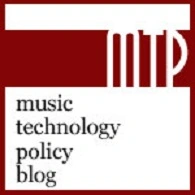
It appears that Music Reports, Inc. (or “MRI”) has applied for a patent for exclusive rights on the process of matching songs to sound recordings and “licensing same”.
The abstract of patent claims for at the application describes the extent of MRI’s exclusivity if the patent is granted. Pay close attention to the word “service” as it is a bit confusing “musical works administration service” which is MRI “to digital music service providers” which is platforms like Spotify.
Disclosed herein is a musical works administration service to digital music service providers (DSPs), to provide a streamlined approach for such DSPs to comply with copyright licensing, accounting, and reporting requirements.
The service receives, from the DSP, information relating to sound recordings used by the DSP during a relevant time period. Using several matching techniques, the service identifies specific musical compositions embodied in each sound recording, and also determines corresponding publisher-share information. Subsequently, the service employs several mechanisms to attempt to obtain licenses for publisher-shares that are not already covered by preexisting client licenses.
Based on the client’s usage of such sound recordings and other related information, the service also performs accounting, reporting, and payment operations for the client. The service, in some instances, receives funds from the client and makes corresponding royalty payments (and makes accounting reports available) to the respective rights holders.
I’m not a patent expert, so when I first read this abstract, I immediately questioned what is special about the patent as it seems to simply describe the clearance process that everyone has gone through since the invention of the cylindrical disc. I realize that the MRI patent is limited to DSPs but I fail to see why this snowflake is special.
Turning to the US Patent & Trademark Office FAQ about patents we find:
In order for an invention to be patentable it must be new as defined in the patent law, which provides that an invention cannot be patented if:
“(1) the claimed invention was patented, described in a printed publication, or in public use, on sale, or otherwise available to the public before the effective filing date of the claimed invention” or
“(2) the claimed invention was described in a patent issued [by the U.S.] or in an application for patent published or deemed published [by the U.S.], in which the patent or application, as the case may be, names another inventor and was effectively filed before the effective filing date of the claimed invention.”
In other words, in order to be patentable, that snowflake really does have to be pretty special. So I still don’t get why anyone should be able to patent the matching.
The abstract appears to be a description of what I understand the MRI business offering to be, especially on statutory licensing of songs. But note that MRI’s patent claims are not limited to statutory licenses.
Given the sustained and abiding interest at DSPs to always be able blame someone else for the DSP’s failure to properly license songs and pay royalties, I was struck by this sentence in the MRI abstract:
Using several matching techniques, the service identifies specific musical compositions embodied in each sound recording, and also determines corresponding publisher-share information.
What the abstract does not reveal is what happens if some or all of the “publisher-share information” is either not known or not licensable (in the case of direct licenses or ineligible statutory licenses). What is clear to me is that any DSP using the MRI patent will have actual knowledge of the “publisher-share information” for 100% of the copyright–including the shares that can’t be found or licensed (in the case of direct licenses).
This is particularly relevant as in the recent press release from MRI in Billboard promoting the patent, an MRI representative is quoted as saying:
“Bottom line: we’ve created a super-efficient mechanism to help solve the problem of mechanical licensing at scale in the United States,” Colitre says. “The DSPs [digital service providers] who use this platform will have bigger cleared catalogs with lower risk; the publishers who use it will get paid faster and more transparently… it is online and operational today.”
Using the patent may have the additional benefit to plaintiffs of simplifying discovery for willful infringement actions since the process will report to the DSP which shares are cleared or create a repository of that information at MRI that can be subpoenaed and then cross-referenced back against works used by a particular DSP. If the patent time-stamps the work done for a particular DSP, it could also be helpful with discovering whether the DSP has complied with the conditions for a compulsory license.
Assuming MRI isn’t going to claim a patent in that process as well.

You must be logged in to post a comment.